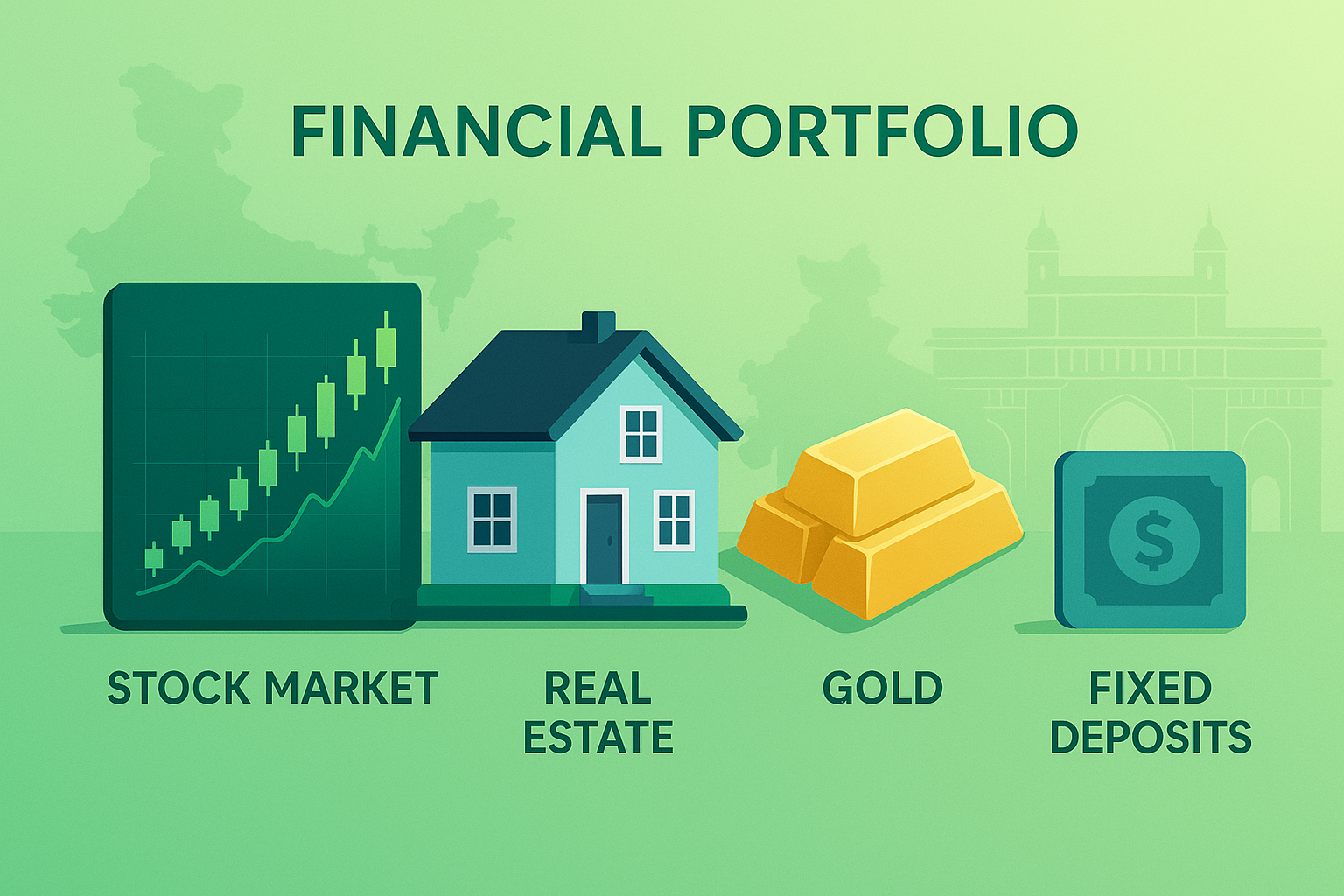Building a Building a financial portfolio in India is not just for the rich or seasoned investors. In fact, anyone, regardless of their income level, can and should start planning their investments early. With the Indian economy growing at a rapid pace, the financial markets are brimming with opportunities for individuals looking to grow their wealth.
In this article, we’ll walk you through the essential steps to build a robust and diversified investment portfolio that fits your goals. Whether you’re a newbie looking to start your first investment journey or an experienced investor aiming to refine your strategy, this guide will help you build a strong financial foundation.
What Is a Building a Financial Portfolio in India?
A financial portfolio in India refers to the collection of investments you hold. It could include stocks, bonds, real estate, mutual funds, and other investment instruments. A well-balanced portfolio ensures that your money is spread across different asset classes to reduce risk and increase your chances of achieving your financial goals.
A strong financial portfolio is essential for wealth building, retirement planning, and achieving long-term financial security. Let’s break down the steps involved in constructing one.
Why is Building a Strong Financial Portfolio Important?
Before diving into the technicalities, let’s quickly look at why it’s important to build a diversified investment portfolio in India:
Financial Security: A diversified portfolio helps secure your future against market volatility and inflation.
Wealth Creation: Through proper planning, you can grow your wealth over time.
Retirement Planning: Starting early allows you to create a solid retirement fund.
Risk Mitigation: A diverse portfolio lowers the risk associated with investing in a single asset class.
Key Steps to Build a Strong Financial Portfolio in India
Step 1: Define Your Financial Goals
The first step in any investment planning in India is to define your financial goals. Ask yourself:
What do I want to achieve with my investments? (e.g., buying a house, saving for retirement, funding children’s education)
What’s my timeline? (Short-term vs long-term)
How much risk am I willing to take? (Risk tolerance)
These questions will give you clarity on the type of assets you should focus on and help you create a personal finance strategy.
Step 2: Assess Your Risk Tolerance
Understanding your risk tolerance is crucial before jumping into any investment. In the Indian context, risk tolerance depends on various factors like:
Age
Income level
Financial obligations
Investment goals
Market knowledge
If you are young, you can afford to take more risks, as you have time to recover from any potential losses. However, if you are nearing retirement, a conservative approach would be better.
Step 3: Create a Diversified Investment Portfolio
A diversified investment portfolio reduces the chances of losing all your money in case one investment doesn’t perform well. It’s crucial to spread your money across different asset classes such as:
Equity (Stocks): High-risk, high-reward investments. These are ideal for long-term growth.
Bonds: Lower risk compared to equities. Bonds provide fixed returns, which can help stabilize your portfolio.
Mutual Funds: A good option for those who prefer professional management of their funds. Equity mutual funds, debt mutual funds, and hybrid funds all have different risk levels.
Real Estate: While relatively illiquid, real estate is a great option for long-term wealth creation.
Gold: Gold is a safe haven and is often seen as a hedge against inflation.
Fixed Deposits (FDs): These are low-risk, low-return investments, but they add stability to your portfolio.
By holding a mix of these investments, you reduce the risk of a major loss while also maximizing the potential for returns.
Best Way to Diversify Investments in India
Here’s how you can diversify your financial portfolio in India:
Equity Exposure: Invest in large-cap, mid-cap, and small-cap stocks. These offer varying levels of growth potential.
Bonds and Fixed Income: Consider a mix of government bonds, corporate bonds, and fixed deposits.
Gold and Commodities: 10-15% allocation to gold can add stability to your portfolio.
Mutual Funds: Opt for a blend of equity and debt funds. Debt funds are less volatile, providing a counterbalance to equities.
Step 4: Focus on Low-Risk Investment Options for Beginners
If you’re new to investing, it’s smart to start with low-risk options. These will provide you with stable returns while you learn about the market. Here are some low-risk investment options for beginners in India:
Fixed Deposits (FDs)
Public Provident Fund (PPF)
National Savings Certificates (NSC)
Debt Mutual Funds
Sukanya Samriddhi Yojana (for those with daughters)
These options typically offer lower returns, but the risk is minimal.
Step 5: Monitor and Rebalance Your Portfolio Regularly
Building a financial portfolio isn’t a one-time task. You need to monitor your investments regularly to ensure they align with your goals and adjust your portfolio as market conditions change.
Rebalancing: Rebalancing involves shifting your investments to maintain the ideal asset allocation.
Track Performance: Use apps and tools to track the performance of your portfolio. Many financial institutions offer these services.
Step 6: Seek Professional Help (If Necessary)
If you’re not confident managing your portfolio, it’s a good idea to consult with a wealth manager or financial advisor. They can help you create an investment plan tailored to your specific needs and goals.
Wealth Management Tips for Indian Investors
Here are some useful wealth management tips that can help you grow your financial portfolio in India:
Start Early: The earlier you start, the more time your money has to grow through compounding.
Avoid Emotional Decisions: Markets go up and down. Stick to your long-term plan and avoid panic selling.
Tax Planning: Use tax-saving instruments like ELSS, PPF, and NPS to reduce your tax burden.
Be Patient: Wealth creation takes time. Avoid chasing quick gains and stay invested for the long term.
Frequently Asked Questions (FAQs)
1. What is the ideal investment portfolio in India?
The ideal investment portfolio in India should be a mix of equities, bonds, gold, real estate, and mutual funds. The exact allocation depends on your risk tolerance, financial goals, and investment horizon.
2. How can I build a financial portfolio in India as a beginner?
Start by investing in low-risk options such as Fixed Deposits, PPF, and debt mutual funds. Gradually move towards equities and gold as you become more comfortable with investing.
3. What are the best investment options in India?
Some of the best investment options in India include:
Mutual Funds (both equity and debt)
Stocks (for experienced investors)
Real Estate
Gold
Fixed Deposits
4. How do I manage a diversified portfolio in India?
To manage a diversified portfolio in India, regularly assess your asset allocation, invest in a mix of low-risk and high-risk assets, and rebalance your portfolio based on market changes.
5. What are some financial planning tips for Indian millennials?
Indian millennials should focus on early retirement planning, utilize SIPs (Systematic Investment Plans), and invest in equities and mutual funds. They should also focus on building emergency funds.
6. What is the best way to diversify investments in India?
The best way to diversify investments in India is by spreading your funds across different asset classes such as equities, bonds, mutual funds, and gold. Ensure a balance between high-risk and low-risk assets based on your investment goals.
7. How do I start investing in the Indian stock market?
To start investing in the Indian stock market, open a demat and trading account with a broker, start with index funds or blue-chip stocks, and slowly diversify into mid and small-cap stocks as you gain experience.
Conclusion
Building a strong financial portfolio in India doesn’t have to be complicated. By setting clear goals, understanding your risk tolerance, diversifying your investments, and monitoring your portfolio, you can achieve financial security and wealth. Always remember, the best investment is one that aligns with your personal financial goals and risk appetite. Whether you’re new to investing or an experienced investor, the key is to start early and stay consistent. Happy investing!








Comments (0)